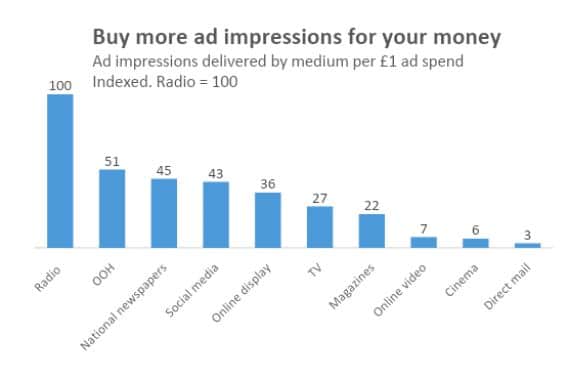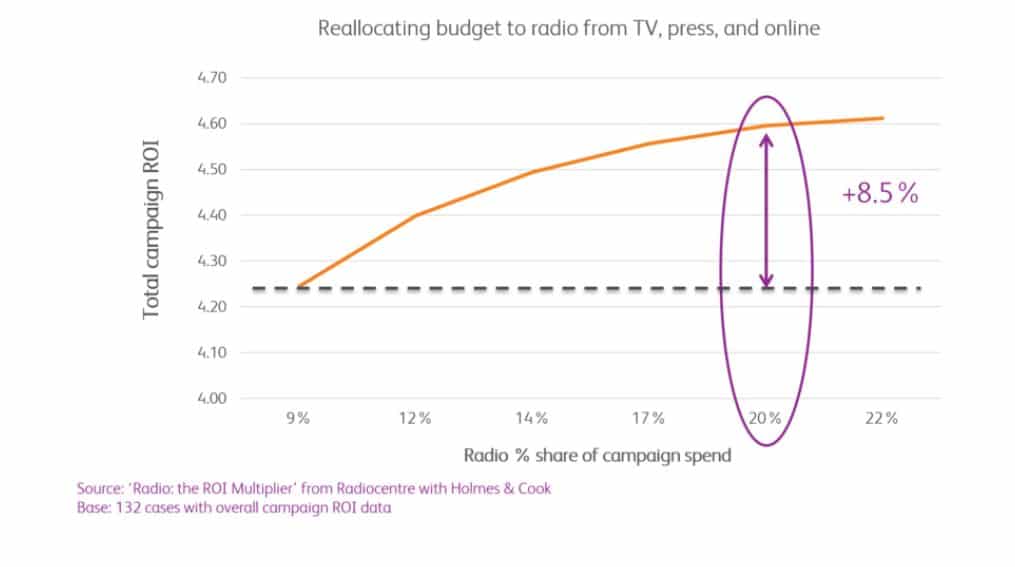The Cost of Radio Advertising: The Definitive Guide
Radio is the perfect medium for SMEs that are looking to grow. With over 49.5 million adult listeners every week, commercial radio is helping business reach out to new customers to not only build awareness but to boost response to websites and increase sales. The cost of radio advertising is often variable, however the ROI of the medium towers above other traditional media such as television or print.
Looking for something specific? Use our handy menu below to jump right to the information you need!
- What is the cost of radio advertising?
- Does radio advertising work once I have invested money?
- How to choose the right radio station for ads.
- How do I target my radio advertising campaign to get the most for my money?
What is the cost of radio advertising?
There are several deciding factors to consider when determining the cost of radio advertising, this article will explain these in more detail or you can download our handy ‘Guide to Radio Advertising’ e-book here.
Does reach effect the cost of radio advertising?
The general rule is that the more people who listen to a radio station, potentially reaching more customers for you, the more expensive it will be to advertise on there. Popular commercial stations such as Smooth North West (over 1,059,000 listeners per week) or Heart Yorkshire (469,000 listeners per week) will be higher in price than smaller local stations such as XS Manchester (127,000 listeners per week). It will be down to you to choose the right station and whether you want to hit lots of people in a large area or a small but more specialist audience locally. At Communicorp UK we work with you to identify your audience and ensure that you are the right station to reach them.
Does number of spots effect the cost of radio advertising?
The larger the number of spots or ‘radio adverts’ you choose to have, the higher the investment will be. Radio advertising campaigns vary in size depending on budget and brand, you may want to choose to play a couple of ads a day or create a more ‘heavyweight’ campaign and pay for between 10-15 spots so that you are covering the entire day. Radio delivers a larger audience than other media throughout the morning and is used by people to accompany tasks and activities across the day, making it easier for brands to reach people at relevant times and in relevant places.

(Source: Re-evaluating Media/Ebiquity – the cost of radio advertising)
It is always best to consider the demographic you want to target. When will they be listening to radio? What are the listening patterns of your target customer base?
Our Campaign Managers will work to plan your spots to when your target audience will be listening, tailoring your radio campaign to their life and listening pattern.
How does the length of my radio advertising campaign effect cost?
Radio adverts can vary from 10-60 seconds, with an average advert being around 30 seconds. Campaigns can run for one to two weeks (short term promotions or giveaways) or a few months to ensure your get your message and brand out there. Again, the longer the campaign the more reach and brand awareness the advert will garner, however shorter, more targeted campaigns can also work just as well.
We would recommend a minimum 3 OTH for your campaign (check out our advertising glossary).
Does the time of my radio advertising spots effect the cost?
Depending on messaging, certain times of the day will work much better than others. Spots are mostly broken down into breakfast, day, evening, and overnight, these are known as ‘day parts’. The most ‘in-demand’ spots are usually breakfast and evening as they have the most listeners. This also comes down to your target demographic, think about when they will be listening to the radio, will they be working from home? Travelling in the car?
If you are not sure, many advertisers also equally spread ads throughout the day to hit a variety of people. This tends to be a typical approach by most marketing teams but your product or service will serve as a good guide to when is most suitable.
Want to know more about how much your campaign would cost? Click here and one of our Account Managers will talk you through the cost of radio advertising.
Should I consider the quality of production on my radio advertising?
The production of an actual advert is an addition that you should consider, this will impact the overall cost of your radio advertising campaign. An ad that includes one simple voice would cost significantly less than a conversational commercial that would feature a number of different voice artists. Again, if you would like ‘well-known’ music on your spot, a fee for music licences may also apply.
Strong creative can also make your ad switch from barely memorable to an instant hit. Read further on radio ad creativity here to get the most out of your campaign.
Does radio advertising work once I have invested money?
Commercial radio is a sure-fire way to speak to millions of people via a medium that they trust. Although often shunned for more modern methods, radio still prevails in advertising. The strengths of radio advertising are endless, however we have pulled together some of the highlights here:
How high is the return on investment from radio advertising?
A common goal for many advertisers is to increase the return on investment (ROI) from their advertising spend. Econometric analysis highlights how moving money into radio from other media leads to greater returns at a total campaign level for no extra cost.
According to Radiocentre, radio produces £7.70 revenue ROI for every pound spent – second only to TV overall and higher in several product categories including retail, finance, travel and automotive.

If I use radio advertising with other media will it enhance my campaign?
The components of a successful advertising campaign include the following:
– Impactful creative
– A clear call to action
– Targeting
– Consistent coverage of key points
– Low cost production and audience delivery
Radio utilises these and plays a highly effective role for an advertiser on its own but placing this alongside other media can create huge impact for your brand, enhancing an overall campaign performance. Read more about radio and digital here.
The most obvious combination is radio and television. Both mediums are widely consumed on a daily basis making it the most powerful and much used media combination, accounting for a high share of the average consumer’s media day. According to Radiocentre, radio is often used to broaden the impact of a TV campaign, exploiting strong audio brand cues to readily bring the brand to mind, triggering visual recall of a TV commercial. Think Go Compare or Chicken Tonight (you’re singing, now aren’t you?).
Probably the second most utilised media combination is radio and online. According to a study taken by Touchpoints in 2017, 16% of time listened to the radio is accompanied by being online. With the increase of AI and advancement of mobile, this will have rapidly grown in the last two years. Taking this into consideration, listeners almost instantaneously respond online to something that they have heard on the radio.
Take retail for example:
Based on Ebiquity’s normative data, retail sector brands that advertised on radio saw up to a £3.01 profit return for £1 spend. That ROI was based on Radio as a primary media. The retailers were more than likely running PPC advertising and paid social. Radiocentre state that when a consumer is relaxing the radio can increase a brands awareness by 72%, more than likely with a mobile device in hand.
Does my radio advertising need to be consistent to be successful?
Historically, it is assumed that to make a big impact consistently you will need a big budget.
Wrong.
Mediums like out of home have, for a while, delivered low cost audience per thousand. According to Ebiquity, radio advertising delivers an average CPT (cost per thousand listeners) of £1.54. Out of home delivered an average CPT of £3.03.
But that is just the average price of airtime or advertising space itself, what about the cost of producing the advert?
According to the advertising decision makers interviewed by Ebiquity, radio production costs only accounted for 2.7% of all media cost. Take this with a pinch of salt. Your budget will move and change depending on your marketing objectives but, in terms of short term sales response campaigns (which won’t run for extended periods of time), the information provided here should prove that you can effectively advertise your offering without breaking the bank.
Is context important when it comes to radio advertising?
It’s 6pm, you’re driving home from work, it’s been a long day and you really cannot be bothered to cook. The next thing you hear is that chime of the McDonalds jingle. Que turning into that drive-thru and buying that cheeseburger.
This is context advertising, aligning a message with an activity, in this example, the weekday rush hour.
According to research conducted by Differentology, brands like McDonalds, Heinz and Deliveroo saw a sales uplift of 51% when they focused on targeting their customers when they were engaged in a relevant activity.
A good advertiser will ensure that your message is reaching the right people at key times of the day by putting them in the context of the consumer. Will your key consumer be listening to radio at work? Will they be doing the school run? Will they be listening as they plough a field?! A brand will know their audience and what they will be doing, therefore making sure the advert hits at the correct touchpoint.
The time of day is not always the focus in advertising, sometimes it can be situational. The morning that Thomas Cook announced it’s collapse, Ryanair were advertising cut-price flights every hour on the radio. A coincidence? Or a very clever advertising placement hoping to help panicking Thomas Cook customers?
According to Ebiquity, Radio is ‘the most flexible medium as it can be used to target audience by geography, demographics, context time of day, day of week and addressability for listeners on connect devices’ .
Business advertising – How to choose the right radio station for ads
You have chosen to add radio advertising to your marketing mix, you know which products to promote and an idea of creative, however have you considered the right station and frequency for your business?
It is important to consider audience demographics as well as how many times your ad is featured in the context of your marketing budget. Throughout this article we discuss some tips on choosing the best radio station and frequency for your advertising.
How do I choose the right radio station and demographic for my ads?
Consider your target persona, do your customers listen to a certain type of music? What are their hobbies? Where do they spend spare time? A deep understanding of your target audiences’ demographics, as well as habits, needs and likes is essential to selecting the radio station that is most likely to reach your target market.
Factors to consider:
– Audience demographics
– Audience loyalty
– Audience engagement
– Station involvement in community
– Station engagement outside or radio, for example, social media, events, and website
How do I decide on the frequency of my radio advertising?
Frequency is the average number of times a person will hear your radio ad, whilst reach is the number of different people who will hear the ad. With a limited a budget, higher reach means lower frequency whereas higher frequency means limited reach.
Research suggests that messages are more effective when repeated, however this can get expensive. A frequency of reaching a person three times a week will give a lasting impression on a listener. Backed up with strong creative and not spreading a budget too thinly (focussing on reaching more people) will give the best impact for your advertisement.
Communicorp UK reaches a diverse adult audience of 3.2 million per week across Smooth Radio, Capital, Heart, and XS Manchester our instantly recognisable radio stations can serve your message to a specific demographic. If you would like to know more about our brands, click here.
How do I target my radio advertising campaign to get the most for my money?
When it comes to advertising, targeting an audience is the most important aspect of your campaign, you would not advertise life insurance to Millennials and ‘hope for the best’, it is important to get your targeting right and when radio advertising is planned correctly it can be a very powerful communication tool.
With the rise of ad blockers online, Lumen Research recently found that only 12% of viewable ads are actually noticed. But you cannot click, skip or block a radio ad. As Radiocentre’s Mark Barber recently said, ‘At a very simple level, if something is not looked at, then it cannot be seen. However, if something is not listened to, it will still be heard’.
Whether it is reaching 38% of people travelling by car to buy groceries or 87% of people working from home who are listening to radio, an in-context radio advert will always be un-skippable.
Throughout this article, we use Ebiquity’s analysis of targeting capabilities to drill down into the flexibility of the of the medium and how it can be used to target audiences in a variety of ways:
What results would I achieve if I target my radio advertising geographically?
One of the most important factors for many advertisers is selecting stations that focus on specific geographic locations. With a range of national, regional, and local stations covering most of the UK, radio is hugely flexible geographically – providing opportunities for all kinds of advertisers to precisely target locations efficiently.
What results would I achieve if I target my radio advertising demographically?
Commercial radio consists of a wide range of stations with a variety of content and playlists attracting different types of audiences. RAJAR data allows advertisers to analyse which stations are best for reaching their specific audience.
What results would I achieve if I target my radio advertising by time/day of the week?
Radio is a predominantly a live and linear medium, meaning that radio ads play out in real time. This allows advertisers to time their advertising to reach people on specific day of the week and/ or specific times of the day to enhance relevance and efficiency of certain messages, where appropriate – just like my Friday night takeaway ad!
How does consumer context effect my radio advertising campaign?
Reaching people at relevant times can help enhance effectiveness and cut through of a campaign. As radio is available on a wide range of devices and doesn’t need primary attention, listeners often use radio to accompany a range of tasks and activities, from the school run, to working, right through to childcare, allowing advertisers to target audiences in very specific contexts.
How does Addressability effect my radio advertising campaign?
With more radio listening starting to take place through connected devices, some radio stations are now able to offer individualised personal data-led targeting of listeners to their streamed content. While still relatively limited in scale this is an important and growing element of the commercial radio offering.
Whatever your objective, radio advertising can play an important role in growing your business. With 36 million listeners per week, let us help your brand be heard amongst the noise.
Think you’re ready to start your campaign? Or just want a chat about the ins and outs of radio, click here to started.

